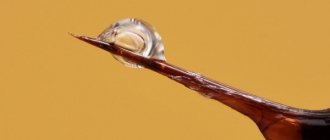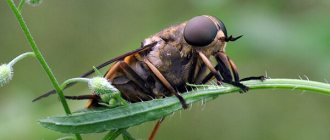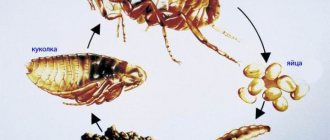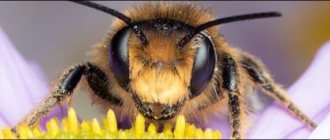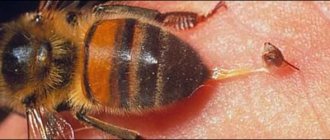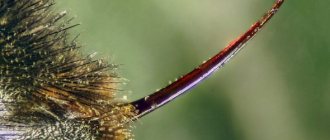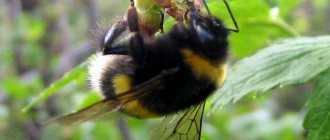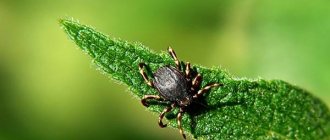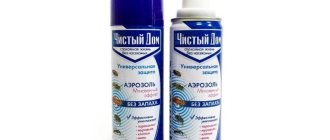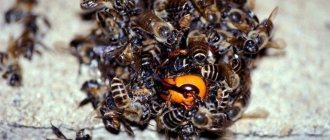Wasp venom: is it useful for the human body and how does it work?
Wasp venom is quite close in composition to bee venom. In addition, many people who are bitten cannot even say for sure whether they were stung by a wasp or a bee - the effects of the poison on the affected tissue are so similar.
Today, scientists have managed to study the composition of both bee and wasp poisons quite well. At the same time, an important distinctive feature was established: wasp venom is somewhat more allergenic and more often leads to complications in the form of various manifestations of dangerous allergic reactions (for example, Quincke's edema, anaphylactic shock). However, you should not think that from this point of view bee venom is harmless - it is also “good” for this, just with a little less probability.
Partly for this reason, “constriction” is not generally known as a traditional medicine method. Despite the fact that bee stinging is a fairly common and well-known procedure.
There is an opinion among experts that the notorious apitherapy and the benefits of bee venom are nothing more than a marketing ploy by beekeepers who need to sell excess of their products. Not a single serious study has confirmed, for example, the benefits of bee stinging, just as the healing properties of other apitherapy methods have not been proven.
It is highly likely that the benefits of propolis, wax moths, royal jelly and bee venom are nothing more than a placebo effect, and these beekeeping products have become widespread precisely because of their availability: they can be obtained from apiaries in almost any quantity.
But it is extremely difficult to obtain wasp venom, because no one breeds them on purpose, and you need to go into the nest of wild wasps to get the drug. And this is another explanation why, despite the similarity of composition, the poisons of these closely related insects vary so much in popularity in folk medicine.
As a result, even doctors and toxicologists today cannot always say unambiguously whether wasp venom is beneficial for humans. It actually contains stimulating and tonic components, substances that stimulate metabolism, but isolating them from the poison is not rational - there are many much safer analogues on the market today, both natural and synthetic.
But due to the large number of harmful and allergenic components, using unprepared wasp venom for treatment can be very dangerous.
Bee and wasp venom - the difference between them
The bee and the wasp only belong to one species: stalked-bellied insects, but there are many differences between them. The most important thing is that a bee can only bite once, after which it always dies. A wasp can bite repeatedly without suffering at all. The behavior of bees is less aggressive; they can calmly react to the presence of a person near the hives. The wasp protects the nest by attacking the enemy, regardless of its size.
An insect can mistake a wave of a hand, and sometimes even the smell emanating from a person, for aggression. If something provokes aggression, then all nearby wasps will attack at once, stinging the enemy until the poison runs out, and sometimes even after that. The bite of wasps is very painful, and they can also bite not only with their stings, but also with their jaws.
Wasp jaw
The wasp's sting is smooth, like a needle. It pierces the skin easily and does not get stuck. The wasp sticks its sting into the skin, flies up and attacks the person again. It's not harmful to her at all. If the individual is large enough, then one bite is enough to cause the most negative consequences. A large amount of poison can cause cardiac arrest even in a healthy person.
Bee venom has a different composition of components than aspen venom. The following groups are distinguished:
- Proteins with enzyme properties. The most famous is phospholipase A2. Its concentration in the poison reaches 14%. In addition, there is a small amount of acid phosphatase and hyaluronidase, which accounts for no more than 3%.
- Toxic polypeptides. Melitin is the most abundant - its concentration reaches 50%. This group also includes histamine-containing peptides, but their concentration is very low.
- Biogenic amines. These are substances such as norepinephrine and dopamine, as well as histamine. In large quantities, they have a strong effect on the functioning of the heart.
Biogenic amines
It should be noted that the composition of bee venom is not a constant value, changing every day of its life. It depends entirely on the age of the insect. It is known that histamine agents reach their highest concentration on the 35-40th day of a bee’s life. The composition of wasp venom is more stable and less dependent on age. The size of the insect is decisive; the larger it is, the more poison it has, the more dangerous it is.
The composition of wasp venom and the effect of its components on the human body
In the vast majority of cases, wasps use their sting primarily for the purpose of self-defense, and only in rare cases to kill larger and overly aggressive prey. Therefore, as a rule, the main purpose of a wasp sting is to cause severe pain in the victim and scare him away.
The composition of wasp venom includes a set of substances that have a strong effect on nerve endings and cause a rapid immune response in the body. Among the main components the following components can be distinguished:
- Acetylcholine is a neurotransmitter involved in the conduction of nerve impulses. At high concentrations, it disrupts the functioning of nervous tissue, blocking the transmission of excitation along nerve fibers.
- Histamine is the main activator of inflammation and allergic reactions. Its action can lead to a variety of manifestations: itching and swelling occurs at the site of the bite, and in especially sensitive people, urticaria, fever, and in rare cases, anaphylactic shock and Quincke's edema develop.
- Phospholipases are special enzymes whose task is to destroy cell walls, which leads to the release of contents from cells into surrounding tissues and provokes an inflammatory process. For the victim, this means pain at the site of the bite, which he will feel while the inflammation lasts. In addition, phospholipases contribute to the destruction of mast cell walls, which causes additional amounts of histamine to be released into the blood and intensifies the allergic reaction.
- Hyaluronidase is a toxin whose action is similar to that of phospholipases.
- A hyperglycemic factor that increases blood sugar levels.
In hornets, the venom also includes specific mastoparan toxins, which have a powerful destructive effect on cells.
“I was once stung by a hornet. In the apiary, I got used to bee stings, they don’t bother me at all, I boldly catch and crush philants. But the hornet hit me so hard that my vision went dark. It’s good that all the evidence was closed. I just walked to the trailer and lay down to lie down. The pain was hellish, my heart sank, all I could think of was to put something cold on my hand. It was badly blown, all the way to the shoulder, and it was very itchy. My apiary neighbor offered to take me to the hospital, but everything turned out okay. The next day, only the itching remained, and then gradually the swelling began to subside.”
Brazilian wasp - cancer winner
At the end of the last decade, one of the UK universities substantiated the assumption that the venom of the Brazilian wasp Polibia Paulista has such a peculiarity of its effect on the cells of the human body when introduced, which is characterized by a special “interest” of some of its components in cancer cells.
According to Paul Beals, who with his team of scientists made this discovery, experiments with the introduction of poison from this species living in Brazil gave the following result.
It turned out that the venom of the Brazilian wasp kills cancer cells, literally tearing them apart, while not having any harmful effect on healthy cells.
The principle of this unique behavior of the toxin is explained by its desire to come into contact with fats such as phosphatidylserine and phosphatidylethanolamine, which usually appear as a second ball around the tumor cell.
OUR READERS RECOMMEND!
To get rid of insects, our readers recommend the Pest-Reject repeller
. The operation of the device is based on the technology of electromagnetic pulses and ultrasonic waves! Absolutely safe, environmentally friendly product for humans and pets. Read more here...
Consequences of wasp venom on the human body
Now let's see how wasp venom works, so to speak, at the macro level, that is, what symptoms arise.
At the moment of sting, the effect of the poison injected under the skin causes sharp pain, and almost immediately leads to the appearance of a small pale swelling at the site of the bite. After a few minutes, the bite swells more, may turn red, becomes hard, and a feeling of severe itching appears on the skin in its area. At this time, the first symptoms of an allergy may appear - hives, fever, shortness of breath, headache, confusion.
Use of wasp venom in medicine
It is for allergy sufferers, for whom wasp stings lead to serious consequences, that special vaccines are prepared based on wasp venom. They reduce the titer of histamine and some toxins, but retain the original amount of specific components by which the human immune system can identify poison.
Before the warm season of the year, when there is a chance of being stung, the patient is vaccinated to develop a normal immune response to the bite. As a result, after an accidental encounter with a wasp, a person’s reaction to a sting will be much less pronounced and not so life-threatening.
Wasp venom can also be useful due to the actual toxins included in its composition. For example, in Barcelona, the development of a method of combating cancer tumors, based on the destruction of cancer cells precisely by the biological components of wasp venom, began quite a long time ago.
Scientists are trying to combine toxin molecules with transport protein molecules that will deliver the poison directly to cancer cells without affecting healthy ones. This drug has already proven its effectiveness in mice, and work is currently underway to study its effect on human tissue.
Protection measures
A wasp sting is harmful primarily to those who are particularly susceptible to poison. In this case, it is recommended to carry out preventive vaccination, due to which histamine and toxins are introduced into the body in small quantities. Vaccination should be done in the second half of summer, when insects become active.
With timely measures taken, you can avoid a strong reaction from the body, which appears very quickly. It should be noted that such vaccination is not particularly popular among the population , but allergy sufferers should pay attention to it. You should also protect people from wasps as much as possible. Thanks to various means and devices, you can quickly get rid of insects both outdoors and indoors.
Thus, one cannot speak affirmatively about the benefits of wasp stings. Most often, they cause pain to a person, and in many people this threatens to turn into an allergic reaction, which can result not only in anaphylactic shock, but also in death.
The most poisonous wasps in the world
Although all wasps are poisonous, the strength of the poison and the consequences of the bites vary from one type of wasp to another. In different representatives of the suborder, the ratio of venom components can vary greatly, and many of them have unique components in their venom that have a specific effect on the victim.
For example, the most painful bite is from road wasps of the genus Pepsis. Most representatives of this genus specialize in preying on tarantulas for their larvae. Their bite is considered one of the most painful insects in the world, and is second in strength only to the bite of the South American ant Paraponera clavata.
The bite of a huge hornet (Vespa Mandarinia), which lives in Southeast Asia and Japan, is statistically the most dangerous among wasps. Every year, about 40 people die from attacks by these insects in Japan alone, and the number of victims throughout the entire habitat of these hornets exceeds a hundred.
The composition of the venom of a huge hornet differs little from the composition of the venom of the European hornet, but in one bite the insect introduces a significantly larger dose of toxins into the human body. In addition, when attacking, a hornet can make several stings at once with a short interval, which often leads to further hemorrhages and extensive swelling. We can say that the huge hornet is the most poisonous wasp in the world.
But Scolia wasps, despite their truly gigantic size, sting rather weakly. Their venom is designed to paralyze prey rather than scare away the enemy, which is why entomologists boldly catch these large black wasps with their bare hands.
Spangled wasps and German wasps sting very painfully. The females of the latter are easily confused with ants due to the fact that they lack wings. These insects are parasites in the nests of other wasps, and it is thanks to their strong poison that they can even defend themselves against hornets by penetrating their nest.
And in conclusion, we note once again: you should not expect that wasp venom will be beneficial for the body. In the event of an accidental sting, this, of course, could be a small consolation, but you should not specifically catch wasps and apply them to the body, because even possible positive effects from the bite will be offset by severe pain, unpleasant swelling and the risk of developing a dangerous allergic reaction.
How does a wasp sting, how does its sting differ from a bee sting?
These are quite aggressive insects, always ready to attack. However, they will not sting a person peacefully passing by. Wasps attack if they are in danger or the threat of ruin hangs over the nest. When biting, the insect pierces the skin of the victim with its sting, injecting poison. Having bitten once, it strives to do it again.
The wasps do not die after the attack. They can sting repeatedly. The number of bites depends on the type of insect, its age and the amount of toxic substance that its body is capable of producing. Wasps usually bite at least 5 times.
Bees, unlike wasps, leave a sting in the wound, dying some time after losing it. The bee is considered the most harmless stinging insect. Wasp venom is much more toxic, so the consequences of their stings are more pronounced than the reaction to bee venom
Appearance
Both species of stinging insects belong to the order Hymenoptera. It is not possible to determine who is bigger at first glance. Bees appear thicker due to their thick hairs. You can tell a wasp from a bee by their appearance.
The main difference is the color:
- Bee color: the body is painted in a more modest yellow tone, intersected by blurry dark stripes. Paws are dark in color. The body is rounded, covered with thick hairs, and the girdle between parts of the body is almost invisible. The abdomen differs in shape, depending on its role in the hive. In workers who collect nectar, it is ovoid. In queens it is oblong. The drones have a body that seems to be truncated and larger than that of an ordinary inhabitant of the hive. The bee's legs are equipped with baskets for storing flower nectar and pollen.
- The wasp looks more elegant. Its abdomen, head and paws are smooth, painted in a deep yellow color, which is clearly separated by a dark pattern. And the abdomen and chest are sharply separated by a narrow belt. The body is elongated. During examination, you can distinguish strong jaws and thin legs.
Lifestyle
Insects also differ in their lifestyle:
- The flight of a bee is soft and leisurely. The nectar collector needs to visit many flowers without missing a single one. The wasp flies rapidly, at high speed, but can freeze in the air for a moment;
- All insects prefer to live in families, which mainly consist of ordinary workers, one queen and drones.
Domestication and Taming:
- Man made comfortable hives for domestic bees. Working individuals produce wax from which they build honeycombs;
- Wild individuals make their nests in tree cavities and mountain crevices.
Wasps also live in groups, where responsibilities are clearly distributed between them. Sometimes they prefer to live as hermits. Their nest is round, as if made of thin crumpled paper. In fact, they prepare it from rotten wood and dry plants.
Dirt and small debris are used to build the nest. They attach their nests to the walls of a house, large tree branches, thick grass, even in a thick plant stem, a discarded mitten, or a piece of cardboard.
Behavior
A wasp and a bee can live in a group, accumulating up to several thousand individuals and alone. The queen begins to build a wasp's nest; first she builds one layer, then the rest. She then mates once with the drone and begins laying larvae, providing food.
At the beginning of summer, the female lays larvae, from which sterile individuals hatch. Closer to autumn, the larvae from which individuals will emerge are capable of reproduction. They develop in a cell, feeding on pre-prepared immobilized insects. Sometimes wasps lay larvae in the body of large beetles. During its development, its status gradually increases. She starts with cleaning the nest and ends with getting food. In autumn, all ordinary individuals and drones freeze, leaving only the queen alive.
In a bee swarm there is also a clear division of responsibilities. Some individuals deliver nectar to the hive. Others put nectar in honeycombs, while others clean the hive of dead individuals. There are cell cleaners, caring for babies and guards who stand at the entrance, the job is to not let strangers through. Defenders protect the home from attackers, these include humans and bears.
Each ordinary worker gradually goes through all the stages of the listed works throughout her life. This is how nature prescribed it. The young individual begins by cleaning the honeycomb. Then she produces milk and begins feeding the queen and young larvae. Then the bee feeds the older larvae with beebread. Then it takes nectar from collecting bees, or stores it in cells. Then the time comes for her to remove the garbage, when her wax glands begin to work, she begins to build and plug the honeycomb. After the 18th day, the glands that produce poison begin to act, then they are trusted to protect the hive.
The bee colony accumulates a supply of beebread for the winter months and for inclement summer days. Closer to autumn, when there is little food, they destroy the drones.
The queen flies out into the wild to mate. In free flight, she chooses a more viable male, sometimes from another hive.
Relation to the uterus
The queen of a bee colony is the main individual. Beekeepers call her the queen or queen bee. All the inhabitants of the hive always take care of her, surround her with a retinue, give her food and drink, and protect her in case of danger. The queen stays in the hive all the time, flying out only to mate with the drones, when it’s time for the bee swarm to divide.
How is a wasp different from other insects? Because they do not take care of their uterus. She finds her own food.
Nutrition
There are also differences in nutrition.
- Vegetarians include bees. They feed only on nectar and plant pollen.
- Wasps need to consume the proteins found in the larvae. They often eat flies and even beetles, which are sometimes larger. First they sting the victim to immobilize them. Then, wrapping their paws around them, they drag them into their nest. They crush weak opponents with their powerful jaws. Can be seen on pieces of rotten meat, fish, carrion. With their strong jaws they tear off small pieces, chew them and give them to their larvae. They love the juice of fresh, rotten fruits, vegetables, and berries. They love to enjoy sweet drinks, beer, and jam.
How else are these insects different? Being aggressive, wasps can enter the hive to snack on protein food. Although the owners of the hive actively defend themselves, they can expel uninvited guests out.
Structure
The body of any bee consists of:
- From a triangular shaped head. A seam runs down the center of the head, separating the bee's compound eyes. The head contains the brain parts of the nervous system;
- Abdomen that ends in a sting;
- Breasts;
- A flexible chitinous layer that protects internal organs.
Upon closer examination, a bee can see two pairs of wings, six pairs of legs with baskets for collecting pollen with brushes. The bee's mouth is equipped with a proboscis, with which it extracts nectar from the depths of the flower. The eye of an ordinary hive inhabitant can contain up to 5 thousand facets, the queen has more, and the drone has about 8 thousand.
The wasp has eyes located on both sides of its head, so it can look to the right and left at the same time. Below the eyes is a forehead with two movable antennae that act as an antenna. They help determine humidity, amount of carbon dioxide and temperature in the nest. The head of the wasp is also equipped with antennae, with their help it determines the size of the cell and the taste of food. The wasp has 6 legs, which consist of 9 segments, attached to the bottom of the abdomen.
People are often stung by wasps and bees; the stings are always unpleasant and painful. But there are differences between bee and wasp stings. Both species are equipped with a sting, but they use it differently.
A bee stinger with retractable barbs that resembles a tiny harpoon. During an attack, the tip of the sting pierces the upper layer of skin, and poison is injected through a thin channel. The difference is that when trying to pull the sting back, the intestines of the hive inhabitant are torn off, which leads to death.
Wasp sting: harm, danger and protection
A wasp sting hurts and can cause severe symptoms. If medical assistance is not provided in a timely manner, anaphylactic shock or Quincke's edema will occur. Scientists equate wasp stings to bee stings and suggest that they have a positive effect on health. Therefore, it is important to understand whether an insect bite provides benefits to the human body or causes harm. It is important that if you are stung by a wasp, you should immediately consult a doctor.
The benefit of wasps is that in the spring they pollinate flowers of different crops: with their paws they transfer pollen from one plant to another. Thus, insects can increase the yield of various crops. Wasps also destroy insects that eat plant fruits. For example, they successfully feast on aphids, caterpillars, flies, and bedbugs. During the day, one adult wasp can eat up to 20 - 30 pests.
Bite symptoms
Externally, the manifestations are practically no different. It is difficult to assess the degree of pain, if a wasp or bee stings for the first time, a person has nothing to compare with. The bite looks like this:
- edema;
- redness;
- swelling;
- pain;
- in the center is a dot with a small depression;
- itching
A photo of a bee or wasp sting is shown below. You can carefully examine all the features of the traces of an attack by striped insects.
Wasp sting
On a note!
If a wasp or bee stings in the leg, injects poison into the arm, the entire limb swells. If you are bitten on the neck, face, or tongue, the likelihood of swelling of the larynx increases. In severe cases, Quincke's edema develops. In the absence of qualified help, a person risks dying. If you are bitten by bees or attacked by a swarm of wasps, the dose of poison in the blood increases significantly and anaphylactic shock may occur.
A severe allergic reaction provokes:
- dizziness;
- headache;
- nausea;
- vomiting;
- diarrhea;
- violation of movement coordination;
- clouding of consciousness;
- fainting;
- blurred vision;
- decreased blood pressure;
- pale skin;
- constriction of the pupil;
- difficulty breathing, shortness of breath;
- arrhythmia;
- increased sweating;
- chills.
At home, it is allowed to treat a wasp or bee sting in case of a local allergic reaction. If you experience deterioration in your health, difficulty breathing, or swelling of the larynx, you should immediately call an ambulance or go to a sanitary checkpoint accompanied by other people.
Wasp venom consists of the following components:
- histamine, which provokes the development of allergies. The affected skin becomes red, itchy, and swollen;
— phospholipases that destroy tissue and blood cells. This component enhances the development of allergies;
- hyaluronidase, which destroys cell membranes, resulting in inflammation in the area of the wasp sting;
- acetylcholine, which conducts nerve impulses;
- a hyperglycemic factor that increases blood sugar levels.
Each type of wasp has its own individual poison. Hornets (large wasps) secrete a poison consisting of matoparana with crabweed. Such polypeptides destroy large human cells and release large amounts of histamine from them.
The benefit of a wasp sting is that hemoglobin in the blood increases, cholesterol levels decrease, and blood vessels dilate. Positive aspects are observed only if a person is not allergic to a wasp sting.
A small amount of wasp venom increases the pulse and increases blood flow to the affected area. If there are too many stings, the skin swells greatly, blood accumulates under the skin, pain in the heart area, dizziness, nausea, and vomiting. In this case, it is important to urgently provide medical assistance to the victim to save his life.
If the question arises about how a wasp sting is useful for a person, we can say that it is more harmful, since it can cause severe allergies, accompanied by anaphylactic shock and even angioedema.
Unlike wasp venom, bee stings are more beneficial. They improve the functioning of the human nervous system, thin blood clots, act as vasodilators, and reduce high blood pressure.
Bee stings, like wasp stings, can trigger allergies, which are dangerous to human health and life.
Does a wasp die after being stung? No, because she can pull out the sting and fly further. Its sting has a smooth surface. Therefore, it penetrates freely into the skin and is also easily removed from it. Bee stings have serrations, which means that if they get into human skin they cannot be removed. The bee flies away, but the sting with poison and some part of the insect itself remain in the bitten area. The wound on the abdomen does not allow the bee to live, so it dies.
First aid for a bite
When wasp venom just begins to take effect, it is important to understand how to help a person eliminate unpleasant symptoms. If warning signs appear, you should:
- Apply a cold compress to the damaged area, which will help reduce the severity of pain and prevent the development of severe swelling.
- Apply a special ointment (Finistil-gel is suitable) to the area of inflammation and redness.
- If you don’t have medications on hand, then you should resort to using soda; dissolve it in warm water and apply a cotton pad soaked in the solution to the skin.
- You can apply mint toothpaste, it will reduce the intensity of the discomfort.
- A cool compress made from herbal decoctions works well; you should use: chamomile, plantain, celandine or calendula.
- Saline solution will also help; with its help, the intensity of unpleasant sensations is reduced. A cotton pad or swab is moistened in saline solution and applied to the bite site for 10–15 minutes. Then the compress is changed.
- A solution of table vinegar will help neutralize the poison. A napkin is soaked in it and then applied to the skin.
There are many universal tips, but if a person has a tendency to allergic reactions of various kinds, it is recommended:
- take an antihistamine before visiting a potentially dangerous area;
- Always carry medications with you that can reduce the intensity of the allergic reaction.
There is another method of combating allergies; it is vaccination. Vaccinations are done under the supervision of a doctor; an allergist deals with this issue. This measure helps prevent a violent reaction, but it cannot completely get rid of allergies.
If a person is allergic to insect bites, then he is recommended to use repellents - these are products that repel not only wasps, but also other potentially dangerous insects: bees, hornets.
What to do if you are bitten by a tick: first aid and further actions.
How to relieve itching from mosquitoes: pharmacy and folk remedies.
It is useful to learn about what to do after a hornet bite: first aid and treatment.
Tips on how to avoid becoming a wasp victim
- Do not pick up fruits or vegetables.
- Avoid using floral scents (perfume).
- Don't wear clothes that are too bright.
- Avoid places where insects are located.
- Do not brush away wasps, refrain from sudden movements.
It is believed that the wasp stings in defense, but it is extremely difficult to predict its behavior. For this reason, in the summer it is so important to pay attention to protective equipment. Following simple rules will help reduce the likelihood of an attack, but you will not be able to completely get rid of insects. For this reason, if you suspect an allergy, as part of prevention, you should consult a doctor and take tests.
https://youtu.be/Np8sBCFsQTw
How dangerous are wasp stings?
Harm from a wasp sting is manifested by the following symptoms:
1. Swelling and inflammation appear in the bitten area, tissue and vessel walls are destroyed.
2. Pain occurs, causing severe itching in the affected area.
3. A person suffers from slight malaise and increased body temperature.
4. Hives and headaches may occur. In severe situations, severe intoxication occurs, Quincke's edema. If you have a severe allergy to a wasp sting, it is important to urgently show the injured person to a doctor in order to provide him with timely help and even save him from death.
An insect bite is also dangerous because it causes sensitization.
There may be no reaction to the first sting, but subsequent wasp attacks can cause unpleasant and even life-threatening symptoms.
Remedies after a bite
The consequences of an attack cannot be completely eliminated with first aid. A person may experience pain and itching in the affected area for several days. It is necessary to use means to reduce pain symptoms and reduce swelling from the bite.
There are several ways to relieve swelling from a wasp sting, reduce pain and itching.
Store products
- Fenistil. Gel that reduces itching and irritation after a bite. Prevents the development of an allergic reaction. Apply a thin layer to the swelling 2-4 times a day.
- Advantan. A highly concentrated ointment that reduces skin inflammation and allergic reactions. It will help relieve itching after a wasp sting. Apply once a day in a thin layer to the affected areas of the skin.
- Menovazin. A budget option, it has a cooling and antiseptic effect. The solution is applied 2-3 times a day, using rubbing movements.
Regardless of the drug chosen, it must be applied for as many days as the swelling lasts after the wasp sting. Typically, swelling lasts from two to five days.
Folk remedies
Not only store-bought but also folk remedies cope well with itching and pain. Let's take a closer look at the options for how to anoint a wasp sting at home:
- Parsley. An effective remedy after a wasp sting. Parsley juice has an anti-inflammatory effect. A lotion of crushed parsley leaves is applied to the bite site and left for two hours. If necessary, you can repeat the procedure.
- Plantain. Has bactericidal properties. It is recommended to make a compress from plantain leaves together with parsley leaves to achieve greater effect.
- Aloe. Helps reduce itching at the site of the lesion and reduce swelling. You can apply aloe juice in its pure form, or diluted with boiled water in a 1:1 ratio.
- Onion. It has a blocking effect on the components of wasp venom. A compress of onion juice will speed up the healing process of the wound and reduce swelling.
- Olive oil. Chilled olive oil has a refreshing and soothing effect. Regenerates and nourishes skin cells, accelerating the wound healing process. Reduces redness and irritation at the affected area.
Whatever remedy you choose, the main thing is to control the healing process of the wound. If swelling increases and general health deteriorates, you should immediately consult a doctor.
